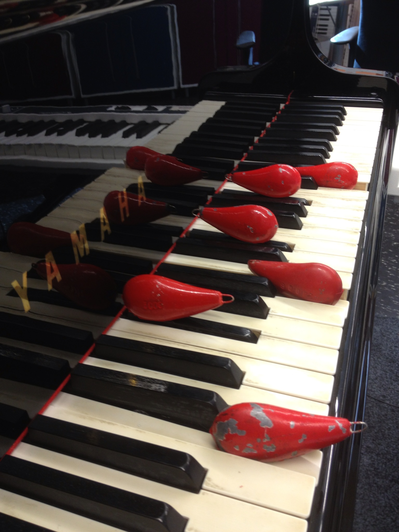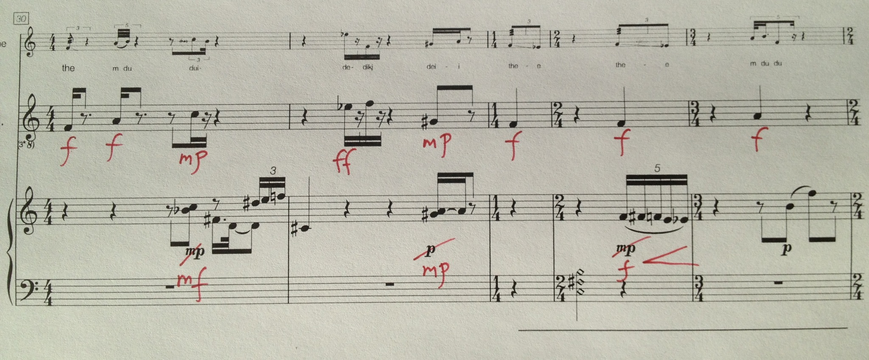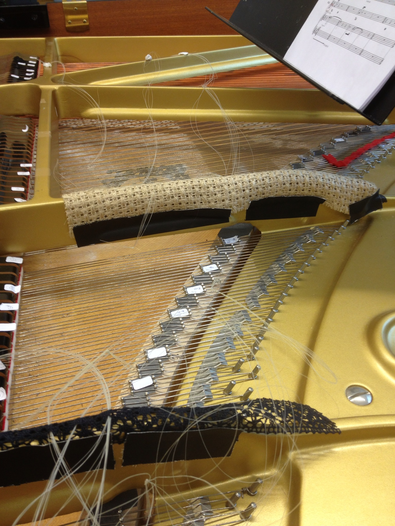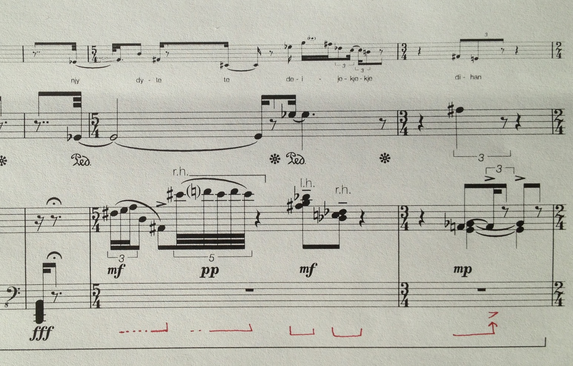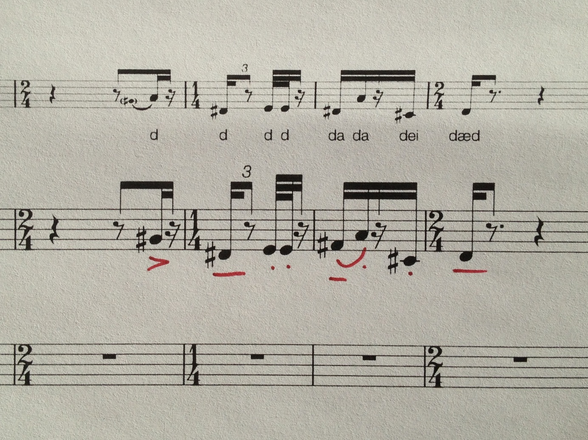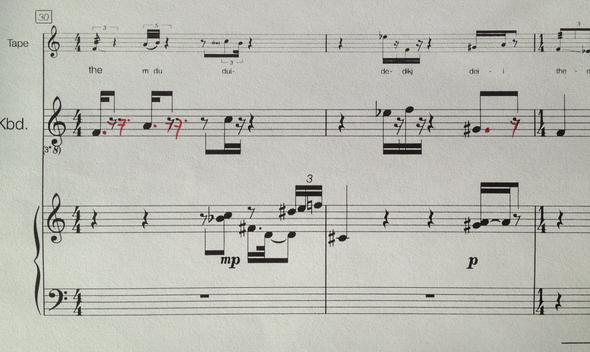The role of the soloist in contemporary piano concerti
- by Ellen Ugelvik
In my research project I investigate the role of the soloist in contemporary piano concerti [1]. Much of this work has been undertaken in the context of ’The Reflective Musician’, allowing me to develop different kinds of collaborative processes as part of the research process.
I will premiere five new piano concerti in the project period:
2013 Dai Fujikura: Diamond Dust. Huddersfield Contemporary Music Festival/GB. Oslo Sinfonietta conducted by Christian Eggen
2015 Magne Hegdal: Konsertstykke i tre deler. Store Studio Oslo. KORK conducted by Bjarte Engeset
2015 Bente Leiknes Thorsen: at the tips of my fingers on the tip of my tongue. The reflective musician festival. Universitetets Aula, Oslo. Ensemble Allegria lead by Berit Cardas
2016 Therese Birkelund Ulvo: Woven fingerprints. Kilden, Kristiansand. Kristiansand Symfoniorkester, conductor Ingar Bergby. Andreas Ulvo, piano 2. Postponed.
2016 Trond Reinholdtsen: New work. Ultima contemporary music festival, Oslo. Oslo Philharmonic Orchestra, conductor Cathrine Winnes
Through the preliminary processes and performances I investigate my role in each concerto and compare these. How is my role different in each concerto? And how is my role different from the soloist’s role in canonical piano concerti? [2]
The background of the project is my previous performances of contemporary piano concerti. [3] I have experienced that the educational and professional concert institutions [4] I have been working with sometimes deal with new works in the same way as canonical works. The presentation, work methods and rehearsal spaces are the same for a piano concerto by Wolfgang Amadeus Mozart and a world premiere of a new piano concerto by Bente Leiknes Thorsen. I believe that these circumstances can lead to unsatisfactory performances of the new music. As a by-product of this, new works are generally performed only once.
In this exposition I shall elaborate on how new piano concerti challenge the structures of the standard classical concert world and explain why I find that the new concerti demand an expanded, multifaceted role for the soloist. To put these ideas into context, I shall present a case study of the third piano concerto in my project: at the tips of my fingers on the tip of my tongue by Bente Leiknes Thorsen.
at the tips of my fingers on the tip of my tongue
I commissioned the piano concerto at the tips of my fingers on the tip of my tongue by Bente Leiknes Thorsen because I am intrigued by how she integrates her children’s voices into music. The work is based on voice recordings of her two sons from the time of their birth until they were approximately five years old. In the work, I play two instruments: a synthesizer in which different samples of the voices are organized and a regular grand piano in which I play on the keys and with different objects inside the piano.
I knew it would be interesting to work with and perform the concerto since the material is of a very personal and somehow provocative nature. I knew in advance that some people in the audience would find this material too private [5] and intimate, while some others would find the material touching and strikingly beautiful because it contains recordings of children. For me, it was a profound and passionate experience working with the concerto, since I started rehearsing my part just after I gave birth to my second child.
I also commissioned this concerto because I knew that Bente Leiknes Thorsen is a composer who works with musicians in a collaborative way. She opens up her works at an early stage and invites the other artists to question the processes. She integrates our knowledge and expertise as musicians [6] and requests an open-minded dialogue with her collaborators. She invites us in as co-creators in her composing project.
The identity of the soloist
This piano concerto was commissioned by me for The Reflective Musician Festival and was supported by Norsk Komponistfond. To commission a new work work such as at the tips of my fingers is a great responsibility. The act of initiating and generating the process by choosing the composer and, as a result of this process, bringing forward and approving this composer’s aesthetics produces risk and places pressure on the soloist’s shoulders. Difficult questions inevitably arise. Is the orchestra going to like working with the piece? Does the audience approve the piece? Do I like the piece?
When I commission a comprehensive work such as a piano concerto, I am responsible for the kind of music that will be brought into the world.
As a commissioner, I was partly responsible for carrying out the practical aspects of the process successfully. A piano concerto is a very expensive art form with several participants. The soloist must follow up the creative processes with the composer so that she keeps her deadlines. I arranged preliminary rehearsals with the leader of the orchestra. I also arranged an open rehearsal to bring issues of the work to the public (such as analysis, deeper understanding of the material for the musicians, showing processes, possibilities for experimentation). I created the presentation material to fit the festival’s program. In the case of at the tips of my fingers, Bente Leiknes Thorsen began working on another idea before she arrived at the material leading to the finished work. I was therefore left with very little rehearsal time for the finished solo material: approximately five to six weeks. She was pushing the deadline. This created stress in the days preceding the premiere, particularly because I was partly responsible for the practical sides of the processes. I had to confront difficult questions; for example, what would happen if we were compelled to cancel the whole piece? In our practice with new music, it is very often the case that the finished material comes late. In this case, I was ‘inside’ the project from the beginning, and I followed what happened closely along the way. In new works, this becomes crucial; even if the composer is guarded and dislikes sharing information, the musicians should insist upon a dialogue from the outset, to get a chance to look into the material, a possibility to get a glimpse of the aesthetics and to develop an idea of how to prepare.
The soloist commissioner also carries great responsibility towards the composer and the music. Bente Leiknes Thorsen uses recordings of her own children as musical material. This material is delicate. My performance of this material is the first sounding musical reference in this particular work, and the way I handle and speak about the material has consequences for the future of the work. This demands insight and empathy. In the first tutti rehearsal with the orchestra, my playing is the first reference to the solo part, to the children’s voices - in this case the most central material of the tutti sound. The way I present the material will be the first reference for the other musicians to perceive the aesthetics, the sound and the attitude needed for this type of material. First impressions become decisive! [7] The soloist in such a work becomes the link between the composer and the orchestra.
In the first rehearsal I felt very strongly that the ensemble immediately linked my identity very tightly to the work. When the leader spoke of the concerto, the solo part was referred to as ‘Ellen’. I ‘became’ the solo part, I ‘became’ the work. Being physically positioned in the middle of the ensemble still gave me a position outside their established ensemble unity. I was the first musician to get in contact with the music, I have worked closely with the composer. I commissioned the work. I am a so-called ‘contemporary music pianist’. Nonetheless, during the rehearsal, the musicians were giggling behind my back, raising eyebrows, and were playing without energy and interest. In the breaks, no one came to me to talk or discuss issues around the work. The ensemble did not want to integrate my part as musical cues in their parts, even though I suggested this as a good idea for playing with more precision. Perhaps it was difficult for them to read while playing because of the complexity of the notation. Whatever the case, this really established my position ‘outside’ the ensemble. The other musicians did not know what I was suppose to play! Sometimes it was as if we were playing two different pieces on top of one another.
We arranged an open rehearsal of the concerto two days before the premiere. The leader of the ensemble, the composer and I discussed the content of the open rehearsal, a rehearsal form that was new to us. The ideas we had for the rehearsal were very different! I wanted to take the opportunity to allow all of us get deeper into the material by finding a way to improvise together over the sample voices - playing, not speaking – embodying the material, experimenting, finding a ‘sound’ together. The leader, Berit Cardas, wanted to speak about performing inspired by ‘four pillars’ from theatre. [8] It was also expected (by the festival) that the composer should give a short analysis of her work, a lecture about the construction of the concerto.
The open rehearsal was a bit messy due to technical problems. We wanted to begin with a run-through of the concerto, but the electronics did not work, so Bente Leiknes Thorsen gave her lecture first. During the lecture, half of the ensemble did not look at the big screen with score examples situated behind them. They were not interested, and indulged in ‘small-talk’, as if this had nothing to do with them! After the analysis, Berit Cardas gave a presentation of her ‘four pillars’ with information of how we can bring the music over the stage and directly to the audience. This presentation was very engaging for the musicians, and after that we did our best and liveliest run-through ever of the piece. It became clear to me that the orchestral musicians identify themselves strongly with their leader; her ideas are crucial to them and make a change in their playing and attitude. The leader has great influence, while in this case, the composer has less impact upon the execution of the material. In this piano concerto, it struck me as well that the material for the orchestra was ‘easy to play’ (long chords, tiny single actions in triple piano dynamic level), and since Allegria is known for their virtuoso playing of classical music, this material did not really appeal to them. My impression was that they found the music too strange and sparse so they could not identify themselves with it.
On stage
When I was busy rigging and preparing the piano on stage in front of the audience, the leader of the ensemble gave an introduction to the work, having fun with my preparation tools. She took the tools out of the piano, held them up, claiming one object needed a battery-change, and then handed out the tools to the audience. This was met with laughter and created a relaxed atmosphere, but a friend in the audience later told me that this introduction really ruined the piece for her. The piece was reduced to something funny and peculiar, the pre-talk affected the possibilities for the audience to sense the music in a pure, undiluted way. For a premiere this is particularly sensitive. A premiere is a unique event, and is completed when the new music meet the receivers: its audience. A premiere is the encounter in which the receivers take part in the music and complete the work for the very first time. We had discussed the pre-talk in advance, but the leader did not want input or a run-through of the talk: ‘we take it on the fly’/’vi tar det på sparket’. ‘I have done this a hundred times before.’
After the pre-talk, the piece began! The opening of the work is a big, loud chord played by the soloist in fortissimo, followed by some ‘colouring’ from the strings in triple piano. Kicking the piece off from the pre-talk was difficult; the comical way of presenting contemporary music always fills me with frustration! I felt not ‘pure and ready’, but aggressive and squeezed into a comical setting in which I was not comfortable. For me, the children’s sounds and the preparation tools were funny and charming in the process, but in the concert performance, the tools were completely integrated in the material, and each and every one in the audience should have been allowed an unspoiled experience where they themselves could interpret the material. The pre-talk filled me with negative tension, and this, of course, affected my playing.
The fact that the orchestra had not integrated my part in their score filled me with frustration as well during the performance. In addition to playing my own part with liveliness and virtuosity, I needed to watch over the orchestra, to adapt to their part instead of playing together with them. This made me feel uncomfortable and unfree. In the concert I felt that my position as a soloist was shifting. Sometimes I was within the ensemble, sometimes alongside; I was somewhere in-between the orchestra and the audience. It was like having an audience both before me and behind me. This situation I have experienced many times playing contemporary music in chamber music settings. The pianist performs with the whole score and has to look after the others, adjusting to and accompanying the other musicians. This is a demanding task, not giving the pianist the ability to focus completely on her own part. In at the tips of my fingers this resulted in a certain latency – the orchestra was pulling the music back, not playing with along with the solo part. This resulted in a heavy expression not suiting the piece at all, in my opinion. After the performance, I was very tired, I felt that I really had to really carry the orchestra through the piece. The fine energy from the open rehearsal was gone. I felt the performance was only partially successful.
The world premiere
at the tips of my fingers was a work without sounding references. Before the first rehearsal, no one had heard the work sounding in a room. Premiering such an experimental work is a challenge for all involved: the musicians and the institutions. The embodying of new aesthetics, new notation and new techniques within a large ensemble is a great achievement. How can such a work be presented to the receivers in the most appropriate way? There is much at stake in bringing such new work into the world.
Unlike related art forms such as opera, ballet and theatre, the traditional music world often ‘frames’ the challenges of premiering an experimental piano concerto in exactly in the same way as performing a canonical piano concerto. This can lead to unfruitful performances of the new music with possible serious negative results:
-the concerto is never performed again;
-the composers respond by making concerti that fit into the practices of the standard music world.
In the case of Leiknes Thorsen’s concerto, we had scheduled a great deal of rehearsal time, compared to other concerti I have premiered. This amount of time could have given us possibilities to develop a deep-rooted relationship with the music and a solid grounding for a great performance. We could have explored experimental work-specific rehearsal methods suitable for this particular piece. But the rehearsal time was cut short, as the orchestra preferred to work on the other (canonical) work for the concert. I believe that, while the new concerto was ready to be presented in a ‘respectable way’, it was far from ready to be presented in a profound, well worked-out way. This attitude – the acceptance of what is ‘good enough’ - can be dangerous for our music society. New music is often not prioritized, and this becomes evident in a performance where every action on the instruments should be carried out with the highest degree of sensitivity and precision.
Is there anything I can do in my role as the soloist to influence and change this conventional attitude? How can my understanding and experience of the processes of studying and performing through this research project influence the climate around the premiere and, through this, transform the sounding result?
Institutions as eco-systems
Every orchestra is an eco-system. In my project, I investigate the soloist’s role as a part of hierarchies that differ for each concerto. Who affects the climate around the working processes and how? Who decides how this new work shall sound, and how shall this work be presented to the receivers? Who decides how we shall work - is it the composer, the second oboist, the director of the orchestra, the conductor, the score archivist, the curator of the festival, the audience or the soloist? Who has the highest rank in the hierarchy?
My earlier experiences in performing new piano concerti have shown me that the conductors often have the highest status in the hierarchy. [9] The conductor organizes the schedule and, through this, determines how we shall work. The conductor has the power to cancel a work. [10] She decides how the orchestral musicians shall be introduced to the work at the first rehearsal. To what degree does the conductor want to go into dialogue with the soloist? To what degree does the conductor want to cooperate with the creator of the work? The conductor’s role is as the leader of the orchestra, and, through this, the leader of the music.
My own role is more ambiguous. The role of the soloist is a mysterious one; with tacit expectations tied to it.
In hierarchical situations, the language chosen by the involved is of great importance in striving for status. [11] In my project, I study ‘power language’ and ‘power techniques’ that are chosen to establish the positions in each case. I have experienced conductors rehearsing only in Norwegian when the composer spoke only English. Discriminating language can be traced. [12] Consider this (real) example of a male composer in rehearsal: ‘You should be MORE like a soloist, more free! More like a diva! You should keep them waiting, FLIRT! Keep them waaaaaiting!!! And theeen....give them juice! Think of the orchestra as a dress you are wearing!’ Through the project, I have also experienced composers putting very high meteronome markings upon their scores, making the music impossible to play, with the purpose that the musicians should practise more.
In the case of at the tips of my fingers the language chosen at the rehearsals was informal and friendly, but sometimes disrespectful: ‘Let’s play the whole shebang (da spiller vi hele sullamitten)’. The already mentioned pre-talk of the leader introduced the concerto in a way that was not appropriate. This established an unwanted attitude.
The soloist as co-creator
Performing at the tips of my fingers on the tip of my tongue was a valuable experience because of the close and fruitful cooperation I had with the composer. I was invited into the process at a very early stage, starting off with many engaging meetings during which we discussed aspects around piano concerti and the different possibilities of the genre. I participated in the composing process by playing and working with sketches and the recorded samples from the very beginning of Bente Leiknes Thorsen’s work. I was encouraged to give comments and suggestions for the composing process and the use of the instruments, and responded to questions concerning notation. We had continuous workshops from an early stage in which we explored extended piano techniques.
Such a collaborative process is fruitful and gives the soloist a role as a co-creator. The composer of the piece makes use of the knowledge of a specific performer and incorporate this knowledge into the work: The way I play becomes an actual part of the piece.
I would like to show some of ways I contributed to the outcome:
1) Balance
In my interpretation of the solo part, I wanted the children’s voices to merge into the same sound world as the piano timbre when I played on the two instruments at the same time. I did not want the children’s voices to lie ‘on top’ of the total sound, but wanted the two ‘instruments’ to melt together. This is very difficult since the piano sound is of a percussive nature, so I needed to adjust the dynamics of the written part. At some points, I also needed to adjust the pedal markings to make the piano sound more expansive, to try to avoid the piano’s innate percussive quality, by keeping some of the tones in the middle pedal or the sustain pedal and allowing this background sound to ring through.
2) Voicing
The samples had different sound levels and quality, so when I played some of the chords it sounded very rough and unsubtle. I sometimes needed to adjust the dynamics of each tone in a chord to give the chord the quality I wanted.
3) Touch
Playing two different key instruments at the same time is challenging. The touch of the keys on a synthesizer is very different to the touch of the very well-known (for me) grand piano. Sometimes I had to add some rhythmical values to the score to keep the same length and the singing quality for merging with the piano sound. The samples also had a certain latency that I needed to consider for playing ‘in time’ with my own piano playing.
4) Mechanical musicality
To play samples on a synthesizer is challenging. Some composers leave sample parts on synthesizers to other musicians, thinking that ‘it is just to press the key’. This is not beneficial. One needs to carry out the samples with a certain skill of piano touch to make them work in a performance situation. In the case of at the tips of my fingers I added articulation to the score to integrate the samples into the musical setting. The samples also need performance instructions!
5) Faith
In my project, I am interested in how the composers give space to the performers. To what degree does a composer trust her soloist’s taste and preferences? What effect comes from giving freedom or keeping the soloist in a tight grip? How is freedom or lack of freedom visible in the scores? In Bente Leiknes Thorsen’s work, there were passages with free spacing. These passages inspire me to listen with extra care. In turn, I feel that the composer trusts me, building up a mutual ownership of the work.
6) Cadenza
The cadenza in a piano concerto has from the birth of the genre been the part of the concerto where the soloist is permitted – indeed required - to put her fingerprints and distinctive stamp on the work. It is often the ‘golden moment’ the audience has been waiting for, where the virtuosity and creativity of the soloist is put to the test. In many contemporary piano concerti, the cadenza is omitted. The reasons for this differ, but sometimes it seems that the composers want to be in control everything, and are afraid of what kind of strange ideas the pianists could introduce within the piece.
Results
The most revealing result of the project is the awareness of my own possibility to influence the piano concerti: how to take the role as co-creator in the processes. I have explored some examples above showing how and where in the process the soloist can bring in her specific knowledge and by this greatly improve the sounding result. I have shown how this is manifested in a score. The premiere is the first reference to a new work and the standard of the premiere and the presentation of the material is crucial for the future of the work. As a soloist I can be an important partner for the composer in her creative process through questioning and developing further the ideas, as well as bringing valuable input, as an editor does for a writer. The composer is the creator of the work, and the soloist takes the role as co-creator in such processes. The result of such a co-operation can affect the future of the work, the accessibility for both musicians and receivers. I can help the composer to organize the score so that other pianists can more easily pick up the score and give other performances of the work.
Knowledge of how the institutions function can give the soloist possibilities to influence the processes. In my preliminary preparation for the concerti, I have developed different work methods such as a workshop with the orchestra five months in advance of the premiere, rehearsals where the composer played the orchestra part on the piano while I played the solo part, group rehearsals with selected orchestral musicians, rehearsals with the composer, soloist and conductor, open public rehearsals with work analysis, dialogue meetings with The Reflective Musician research group and composers, and separate rehearsals with the conductors and the composers. My wish is to access the concerti by playing and talking in different ways, to experiment together with the goal of embodying the music together as an ensemble. I want us to carry out the music as a unity where every one of us has a profound relationship to the music. To achieve this goal, I find that one needs to create unique work methods for each concerto, and explore other methods than those used on a Mozart concerto, where everyone already has an embodied understanding through their comprehensive classical musical training.
Experimenting with different work methods has led to some fruitful results in my project. It is hard to apply new work methods to an orchestra because each institution is an exclusive eco-system with inner constellations which are hard to grasp and penetrate. An orchestra is a large institution, heavily influenced by politics and economics, and to create change (for example, in a schedule for a concert production) is a challenging task. Still I have found fruitful approaches. Creating work-specific dialogue and vocabulary in advance of the first tutti rehearsal has been a strong achievement. By developing a vocabulary together through playing and talking with the conductors, leaders, composers and some fellow musicians in advance of the first rehearsal, I have been given possibilities to lift the work to a higher level of understanding earlier in the processes. From there, we have accessed the music from another, more persuasive angle and gained a more profound understanding. I have learned that the words chosen to describe a work are of equal importance as playing instructions written by the composer in the parts. By creating an artistic dialogue together, we chose a joint path towards the core of the performance. For my future performances, I will aim for more cooperative processes in advance of the commissions. I find a piano concerto to be a collaborative process; we should aim for a way to involve everyone at an earlier stage, to develop dialogue, ownership and understanding from the very first day. In a new piano concerto I now am in the process of commissioning, I will do a joint commission with conductor, orchestra, composer and myself: shared responsibility, shared ownership and shared risk.
In the project I had the chance to do one tutti workshop with one of the concerti five months in advance of the premiere. For me this was a crucial moment – to get a chance to experience physically the tutti sound in advance of the premiere, an experience rooted deep in body and mind when I worked further on my solo part. This led to a freedom and lightness in my playing, something secure to trust, an embodied understanding of what we were aiming for. After the workshop I worked alone with the composer on precise notation and further development of the playing techniques. The composer developed the material from the workshop and completed the whole work based on the sounding experience. We all knew what was ahead of us. Such a workshop lifts the work to a higher level and gives all of us the opportunity to improve the quality of our interpretations, through experience and embodied understanding.
In the project I have experienced some examples of power struggles and discriminating language. Through the work in The Reflective Musician research group I have had the chance to experience how different people working in the field (composers, writers, musicologists, performers, conductors) experience and speak about performance and creation of a piano concert, and through this I have developed a deeper understanding of why and how such power struggles and language comes to the surface. The dialogue with the research group has given me knowledge of the challenges of the roles of the others involved in a concerto and how they think and act. Their expectations and responsibilities are tied to their personal roles and have given me valuable insight concerning my own role. Together, we have tried out different approaches like open rehearsals, different types of analysis of a work, presentations and dialogue meetings. We have discussed and tried out different ways to experiment with and approach a piano concerto.
Ending
In my career as a concert pianist, I am working principally with contemporary music. I am a classically-trained pianist, but early on, I became interested in experimental music and music that challenges the traditional concert situation. Nonetheless, I have chosen the traditional and petrifying genre the piano concerto for my research project! This might seem like a contradiction, but I find this an ideal situation to study how we play and think about new music, since the piano concerto is a familiar situation to which we all have a relation. In such a fixed form, it is easier to compare the project material. It is a concert form with a large audience, a big-budget event that brings a high degree of risk to the performances. This makes my project important for our music society. It is a concert form encircled with myths and tacit expectations as well – a fascinating spot for studying and unveiling certain secrets…
Through the project I have experienced that the role of the soloist premiering contemporary piano concerti differs for each performance. My role has many nuances within each work as well. The role of the soloist is multi-faceted, and requires consciousness and sensitivity because it shifts very frequently: timing and awareness of the shifts are crucial. There is not one toolkit to be used on all concerti. In my position as a soloist today, I will bring the performing knowledge and reflections from the project into new performances already scheduled. I have premiered several large works and reflected upon the soloist’s role in each work; this gives me a strong position from which to pass on knowledge to other soloists and students performing new music with orchestras. The knowledge can also give composers a valuable insight in the processes around a piano concerto and it may assist them in how they work out their material. Hopefully my study can influence the institutions as well to be open to alternative work methods that can lead to greater performances – giving each piano concerto a longer life.
When I started out the project, I claimed that the role of the soloist in contemporary music is different from the role of the soloists in previous times. During the project, I found that this is correct in very many ways, hence the different challenges in each work, new skills required in each work, and different aesthetics applied in each work. Another aspect that differs from the soloists in earlier times is that the space of the soloists of today seems tighter [13], more restricted; the soloist seems more like a tool for the composer and the tacit expectation is of a strict nature. I should play ‘perfectly’, be without questions, an authority not seeking, not questioning. In my role as a soloist in contemporary piano concerti, I want to do a ‘backflip’ to beginning of the 20th century, draw some fine lines backwards and find some inspiration to shed light on my own role, and give my self a clearer and larger space in which to work. [14]
References:
[1] Piano concerti with modernistic aesthetics. [back]
[2] Famous piano concerti without modernistic aesthetics. [back]
[3] Ausklang by Helmut Lachenmann, Double Concerto by Unsuk Chin, Poesis by Ingvar Lidholm, Concerto for piano and ensemble by John Cage, Axes by Casper Cordes, Musical Grafitti by Asbjørn Schaatun. [back]
[4] Music schools, music academies, management, concert halls, ensembles and orchestras.[back]
[5] Referring to the ongoing debate around autobiographies such as Karl Ove Knausgårds My Struggle. [back]
[6] Some works incorporate the musicians directly into the works, a so called ’performer specific work’. ’Woven Fingerprints is written for Ellen Ugelvik and Andreas Ulvo and they have been crucial in the process. Their fingerprints are very present. Traces of Ellen and Andreas is brought out to the orchestra in different ways. All the material is in some way sourced from my intense listening to Ellen and Andreas playing.’ Therese Birkelund Ulvo in the preface to the piano concerto Woven Fingerprints. [back]
[7] Described as ’Exaggerated Emotional Coherence/Halo Effect’ by Daniel Kahneman in Thinking, Fast and Slow (2011). [back]
[8] A lecture by Berit Cardas based on her training as an actress. [back]
[9] ’I must say that most conductors try to be very cooperative, depending on the respect they have for the soloist. Conductors respect those soloists who know the entire work rather than the few notes they have to play. … Once a conductor is past seventy, there’s little good in arguing with him. … The conductor has to maintain his authority over the orchestra. If he feels insecure, he’ll look on the soloist as a challenger.’ Alfred Brendel (March, 1991, pp. 31). [back]
[10] One of the piano concerti in my project was cancelled due to illness in close family leading to a delivery from the composer three days after deadline. I called the conductor begging him to alter the decision by the director the same day of the cancellation, but he declined and had already scheduled a canonical orchestra piece instead of the new concerto. [back]
[11] ‘By drawing attention to the language itself it can be revealed that certain beliefs remain as invisible, but guiding assumptions, both for the humans understanding of society and their self-understanding.’ (Fredrik Engelstad, 2005, pp. 17) [back]
[12] ‘Another issue is to which extent what you hear can be isolated and perceived unaffected by what you see. With a beautiful female pianist plucking the strings, pulling red plastic cups over the keys and slapping the piano with the palms and a hammer it is impossible to omit the visual impressions. The visual impact that takes a lot of attention is hardly the composer's intentions. ‘ Review of my performance of Ausklang, Knut Helbekkmo (Bergens Tidende, 2010) [back]
[13] Refering to the debate on authenticity, authentic performance practise, historically informed performance [back]
[14] ‘I shall send the cadenzas and introductions to my dear sister at the first opportunity. I have not yet altered the
introductions in the rondo, for whenever I play this concerto, I always play whatever occurs to me at the moment. ‘ Wolfgang Amadeus Mozart in a letter to his father 22.1.1783 [back]
